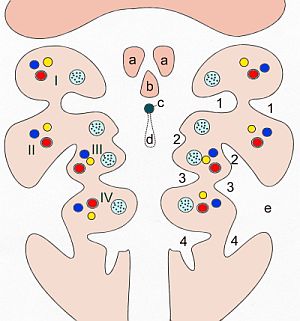Pharyngeal apparatus
Anatomical structure in embryonic development
| Anatomy and morphology | ||||||||||
|---|---|---|---|---|---|---|---|---|---|---|
|
Overview[edit | edit source]
The pharyngeal apparatus is a complex structure in the embryonic development of vertebrates, including humans. It plays a crucial role in the formation of the head and neck. The apparatus consists of the pharyngeal arches, pharyngeal pouches, pharyngeal grooves, and pharyngeal membranes. These structures contribute to the development of various anatomical features such as the face, neck, and throat.
Pharyngeal Arches[edit | edit source]
The pharyngeal arches are a series of bony and cartilaginous structures that support the pharynx in the embryo. Each arch is associated with a specific cranial nerve and gives rise to distinct anatomical structures. There are typically six arches, but the fifth arch is rudimentary in humans and often not visible.
First Pharyngeal Arch[edit | edit source]
The first pharyngeal arch, also known as the mandibular arch, forms the maxilla, mandible, and parts of the ear. It is innervated by the trigeminal nerve.
Second Pharyngeal Arch[edit | edit source]
The second pharyngeal arch, or hyoid arch, contributes to the formation of the hyoid bone and the stapes of the ear. It is innervated by the facial nerve.
Third Pharyngeal Arch[edit | edit source]
The third pharyngeal arch forms parts of the hyoid bone and is innervated by the glossopharyngeal nerve.
Fourth and Sixth Pharyngeal Arches[edit | edit source]
The fourth and sixth pharyngeal arches contribute to the formation of the larynx and are innervated by branches of the vagus nerve.
Pharyngeal Pouches[edit | edit source]
The pharyngeal pouches are endodermal outpocketings located between the pharyngeal arches. They play a role in the development of the thymus, parathyroid glands, and parts of the ear.
Pharyngeal Grooves[edit | edit source]
The pharyngeal grooves, also known as pharyngeal clefts, are ectodermal invaginations that separate the pharyngeal arches externally. In humans, the first groove contributes to the formation of the external auditory meatus.
Pharyngeal Membranes[edit | edit source]
The pharyngeal membranes are thin layers of tissue that form at the junction of the pharyngeal pouches and grooves. They contribute to the formation of the tympanic membrane.
Developmental Significance[edit | edit source]
The pharyngeal apparatus is essential for the proper development of the head and neck. Abnormalities in its development can lead to congenital disorders such as cleft palate, branchial cysts, and DiGeorge syndrome.
Related pages[edit | edit source]
Search WikiMD
Ad.Tired of being Overweight? Try W8MD's physician weight loss program.
Semaglutide (Ozempic / Wegovy and Tirzepatide (Mounjaro / Zepbound) available.
Advertise on WikiMD
|
WikiMD's Wellness Encyclopedia |
| Let Food Be Thy Medicine Medicine Thy Food - Hippocrates |
Translate this page: - East Asian
中文,
日本,
한국어,
South Asian
हिन्दी,
தமிழ்,
తెలుగు,
Urdu,
ಕನ್ನಡ,
Southeast Asian
Indonesian,
Vietnamese,
Thai,
မြန်မာဘာသာ,
বাংলা
European
español,
Deutsch,
français,
Greek,
português do Brasil,
polski,
română,
русский,
Nederlands,
norsk,
svenska,
suomi,
Italian
Middle Eastern & African
عربى,
Turkish,
Persian,
Hebrew,
Afrikaans,
isiZulu,
Kiswahili,
Other
Bulgarian,
Hungarian,
Czech,
Swedish,
മലയാളം,
मराठी,
ਪੰਜਾਬੀ,
ગુજરાતી,
Portuguese,
Ukrainian
Medical Disclaimer: WikiMD is not a substitute for professional medical advice. The information on WikiMD is provided as an information resource only, may be incorrect, outdated or misleading, and is not to be used or relied on for any diagnostic or treatment purposes. Please consult your health care provider before making any healthcare decisions or for guidance about a specific medical condition. WikiMD expressly disclaims responsibility, and shall have no liability, for any damages, loss, injury, or liability whatsoever suffered as a result of your reliance on the information contained in this site. By visiting this site you agree to the foregoing terms and conditions, which may from time to time be changed or supplemented by WikiMD. If you do not agree to the foregoing terms and conditions, you should not enter or use this site. See full disclaimer.
Credits:Most images are courtesy of Wikimedia commons, and templates, categories Wikipedia, licensed under CC BY SA or similar.
Contributors: Prab R. Tumpati, MD

